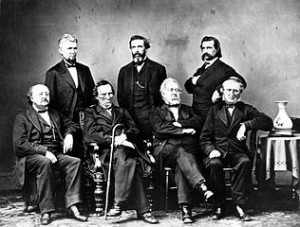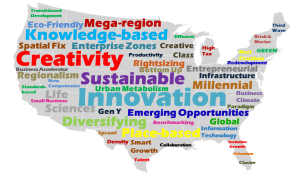Give me that old-time religion — Innovation is good enuf for me!

By The Economic Development Curmudgeon
Innovation has become the rage du jour in economic development. Politicians, especially governors, have incorporated it into their state economic development platforms and policy initiatives. What is this innovation thing and how has it changed in recent years”? And why has innovation become so pervasive in state and local economic development public policy? Let’s take a stab at discovering why. The backdrop behind our questions is that despite our support and belief in the power of innovation and its knowledge-based economic growth, we think (1) the strategy does have weaknesses which are being ignored and (2) it has become part of a political bandwagon that seems almost unstoppable.
Opening Thoughts: Everything is Possible Through Education
Much of the media commentary, political platforms, academic articles and “policy stuff” concerning innovation is pervasive and reads like church-speak; like the stuff you hear in most sermons.
Do good and go to heaven; innovate. grow and prosper; we all can be smart, and learn the vital skills/knowledge to be a knowledge-based elite; and “an innovative entrepreneur through education” is the secular Spock-like path to economic heaven. In my opinion, this path to heaven relies upon a faith-like acceptance that each of these propositions is correct and that one proposition leads benevolently to another. To connect these propositions, assertions (usually in the form of tables and statistics) are made which act like glue to connect these fragile elements–allowing us to believe in the goodness and inevitability of this path to economic heaven.
The support for these assertions rely on what we think ar weak indicators (patents, educational level), but even more damaging is the assertion-belief that education, like salvation, is available to all in relatively short order. The proof of these concepts through imperfect statistical indications and a faith-like belief that education is our ultimate salvation are accepted largely because they have become part of the belief-system of the innovation’s herd-like true believers. In this sense has innovation become a secular economic development religion?
Like any good religion, innovation advocates assert a heaven-like future, that is, of course, inevitable–at least so long as one conforms to the tenets of the innovation religion. Layered on top of church-speak is jargon; it seems to the Curmudgeon that almost every other word is twelve to fifteen letters long and holds a specialized meaning known only to the high priests of innovation. Reading the innovation/knowledge-based economic development literature is like reading Latin at the old-style Catholic church missal for mass. The abstractness/futurism of innovation’s core premises, the connecting glue-like assertions, and the jargon inhibit both understanding and questioning.
The astute reader should perceive that my initial take on innovation is that it has assumed the form of a secular, rational-based religion–a religion without a god; a bible of correlations drawn from indicators applied to a dubious set of databases. Cynically, on a bad day, the Curmudgeon wonders if, alongside the secular religious intelligentsia, there also exists a cottage media-academic-consultant-Think Tank innovation industry, sort of like the military-industrial complex, that lives off this “innovation” blitz? In the spirit of Easter, around which we write this article, it is time for someone to chase the money-changers out of the Temple?
Anyway, the problem for me is that I am a true believer in innovation as a growth machine. Despite its present day religion-like form, innovation itself is real and a very powerful economic driver. Innovation is a legitimate economic development strategy–but our position is that it is not deserving of the religion-like status it has evolved into. We need to be able to question innovation more than we do–and to challenge even its core assumptions without being dismissed as an intellectual or policy Luddite. In this way we can understand better what innovation can do and better appreciate that innovation is a two-edged driver of economic growth and individual decline. In the short and medium term, innovation can be quite disruptive and hurt some segments of society very, very much.
Grabbing ahold of this “innovation” thing is like grasping a handful of gravity. The word “innovation” means so many different things and includes so many potential elements/aspects that, like a greased pig, the concept goes in and out of your hands. Our first task in talking about innovation and economic development is to isolate for discussion just a few of the many concepts and themes that can be found within its confines. Accordingly, our first interest is trying to assess how innovation has been treated as an economic development public policy over the last few decades and then capture a sense of how it has evolved since that time.
In our judgment a fine starting point for innovation and economic development is found in the early 1980’s in the form of a report by the well-respected (sincerely) Joint Economic Committee of the United States Congress. That report is helpful because it combines both the academic and political world’s best thought on the issue at a time when innovation as an economic development public policy was just leaving its “starting blocks”.
“U.S. Climate for Entrepreneurship and Innovation”, 1984
Joint Economic Committee Congress of the United States
One of the earliest efforts of our national government to understand and set the federal government’s policy in regards to innovation occurred in 1984 by the Joint Economic Committee of Congress (1984: ironic because Republicans controlled the Senate and Democrats the House of Representatives). This bi-partisan decision-making committee, reaching its conclusion at a time when compromise was still allowed and at least less polarization was evident, offers hope for a more consensual image of innovation and its utility as an economic development public policy. The study, makes an excellent starting point to outline how innovation was conceptualized in these early years and some principles that, at the time, were felt to be key to structuring an economic development strategy. Further, this early policy assessment is helpful to us because it captures the essence of innovation–without most of the moving parts/bells and whistles that have been added by the many brilliant minds since 1984. It even offers a greater blessing of being straight-forward with minimal jargon and blather.
We do not present the findings and recommendations of this bi-partisan report as truth from which we have subsequently departed, or even suggest that this early federal approach to innovation is the way things should be today. Rather we use it as a benchmark to demonstrate to the reader how far federal (and state/local) government policy has traveled or wandered, depending on one’s perspective, in the thirty years since it was written.
Disarmingly, the Report’s initial caveat about innovation, which it associated with Route 128 and the Silicon Valley, asserted that the “geographical location of these two centers was attributable to historical accidents” (p. VI)–that is where the maverick innovators wound up due to their own personal reasons. They argue that these innovative centers grew out of private sector, industry-specific factors and were launched by entrepreneurs from these industries (who earlier worked for or developed associations with university research labs). Because of this geographical-entrepreneurial serendipity, the report asserts “that as a policy premise government should NOT target specific industries or areas” (p. VII). Quite importantly the report asserts that innovation is essentially a private sector phenomenon.
Innovation is a process that occurs in old and new industries …. it results from the application of new ideas to organizing economic relationships and solving economic problems…. Indeed, an innovation policy is one that should emphasize a “level playing field” upon which entrepreneurs compete to achieve desirable outcome. (p. X-XI)
The Curmudgeon notes that contemporary innovation strategy departs dramatically from this position in that it selects for special emphasis “growth and socially desirable” industries and sectors, and consciously targets “gazelles”, high job-creating firms in these growth industries for aggressive governmental and non-profit assistance and incentives.
Rather, the 1984 report argues that government can foster innovation best “by removing barriers” as well as providing incentives. In the Joint Committee’s view, government’s innovation as an economic development strategy is more attune to a business climate strategy. In such a view the most promising economic development innovation initiative would be to lower capital gains tax rates, which were believed to be a critical variable in the location of the vitally important venture capital sector. The key issue at that time was securing early stage financing for innovation entrepreneurs. High capital gains tax rates were felt to be the worst barrier and best incentive for innovation. We might also mention that the link of innovation to job creation, indeed high rates of job creation was weak to non-existent in the Joint Committee report. The focus was on encouraging greater entrepreneurial risk-taking.
Thus, while not directly targeting individual firms, or selecting certain industries, government policy, by fostering a favorable environment can either serve as a barrier or incentive to economic and innovation growth”…. By contrast, it seems all but certain the Government would have failed if it had tried to plan a Silicon Valley or Route 128…. policy should instead focus on establishing favorable climate for innovation and entrepreneurship…. without the environment for innovation and entrepreneurship, the risk, even for the risk-takers, becomes almost prohibitive. (p. VII-VIII)
The Committee cited other critical barriers imposed by government which stymie innovation and entrepreneurship: high federal deficit, an under-utilization of universities and government labs as agents of technology development and transfer, excessive use of direct loans and tax incentives to attract industry by State and local governments, tax code in need of reform, antiquated antitrust law, tariffs and protective quotas, and inadequate patent and copyright protection. The reliance on these policies reflects the report’s sense that innovation is chiefly a private sector dynamic. Route 128 and the Silicon Valley were the 1984 models of innovation policy. Government’s, especially the federal government’s role was secondary.
The second recommendation-observation of the Joint Committee’s report is that “the secret to success” in the process of innovation and entrepreneurship is people”. (p. VIII). “To this end, the report advocates an incentive-based approach … which permit many employees–including those at the lower and middle levels–to share in the benefits of firm success”. A final recommendation was that “government should not insulate companies from their own failures”. Noting that “fewer than 5% of the entrepreneurial companies founded in the Silicon Valley succeed…. it would be a terrible mistake for our government to attempt to save the 95% that fail.”
If so, arguably the most observable difference between the 1984 federal perspective on innovation and today’s perspective is the centrality of government to innovation. Innovation now is no longer the province of the private sector. Now public policy through the involvement of an activist government can nurture innovation and entrepreneurship by permitting growth and access to venture capital, deregulation, improvement in patents, technology transfer from federal government laboratories. The role of universities and innovation-sensitive non profits in identifying, fostering, guiding, if not directing the path of an innovating entrepreneur has become a cornerstone of innovative economic development.
Just imagine how Edison (Oppenheimer, or Jobs, or Gates, or Salk) would have achieved so much more in today’s environment. He (they) could have found a mentor, been instructed in the best techniques, shared innovation with others in a non-competitive open source environment, received input from successful entrepreneurs in putting together a business plan, and would never have lacked for funding. Instead of working in his own isolated lab-research park, he could have found free space in an university accelerator. A life and enormous potential for innovation wasted in an unnecessarily previous harsh world–what could he have done in our present day innovation centers! (some readers might think this last sentence was sarcastic?)
It is interesting to note that at this early stage in innovation policy, the linkage of innovation to entrepreneurship is intense–the two almost seem to be flip sides of the same coin. “Risk bearing, organizational skills and foresight are the key attributes of entrepreneurs. [Accordingly] Entrepreneurship cannot be taught, but it can be nurtured …. the main focus of this study is on the process of innovation in which the entrepreneur is seen as the primary catalyst for long-term economic growth”. Innovation arises from the dynamics of change within capitalism, by capitalists who take risk, and who when they succeed disrupt established processes and business models, and create new ones as they grow. This is pure Schumpeter–although he is never cited in the report. That observation suggests that our next step will be to take a gander at what Schumpeter had to say about innovation.
The Schumpeterian Approach to Innovation
Schumpeter saw the corporation as the source of growth–a growth characterized by disruptive but transformative change. Schumpeter’s model of growth prepared the ground for such concepts as “innovation”, “entrepreneurship”, “strategy” (upon which Michael Porter launched his very distinguished career), as well as creative destruction. His signature concept was understanding the nature and the importance of innovation, and the subsequent destruction of obsolete firms and jobs. that innovation fostered, Economic growth that resulted as new firms and jobs in greater numbers and more highly paid replaced those firms and jobs which were destroyed. Innovation created increased wealth, prosperity and through new disruptive technology and creative destruction improved the quality of life and furthered what economists describe as “progress”.
Schumpeter held a bottom-up, micro-economic, individual firm based innovation. Firms in their aggregate drove the economy; individual firms are the basic unit of innovation for an industry sector. Thus the source of job growth in this perspective came from the individual-risk-taking entrepreneurs, the firm’s business model and corporate strategy, and the innovative, market-creating, profit-enhancing production processes and technologies employed by the firm. A subset of these firms, led by such an entrepreneur willing to take risk, will “innovate” and in so doing will disrupt in some way the sector paradigm. This innovation by risk-taking firms and entrepreneurs, if successful, will yield increased profits, new markets, increased market share and eventually job growth as well as brand new industries and sectors.
These new firms will, in so many words, crush or disrupt older, traditional-conventional firms. Non-innovative firms will garner fewer revenues and incur higher costs which will eventually result in loss of market share and profitability which if unremedied will result in job loss, and eventual bankruptcy. And so, creativity and innovation by risk-taking firms and entrepreneurs raises profitability and market share of the disruptors and destroys those firms and jobs which are disrupted. This is the now famous “creative destruction”. Over time, more jobs often in entirely new industries will, Schumpeter asserts, create more jobs than those lost, and will yield increased economic and personal prosperity. Creative destruction is the engine which drives the capitalist system and makes capitalism the best economic system over all alternatives in terms of generate growth and prosperity. Because of creative destruction, capitalism, however, is a very fragile system; innovation, being disruptive, hurts firms and people. In the short term the disadvantaged seek relief and political and economic system change is a constant threat.
The Schumpeterian framework served as the launching pad for the sub-discipline of innovation economics. Between 1950-1990 scholars such as Solow, Lucas, Romer, and Krugman contributed thought and research from which innovation and knowledge-based economic development strategies followed. More or less, the 1984 Senate report not only mirrored the Schumpeterian conception of innovation, but introduced these strategies into real life economic development. Subsequent Twenty-first century innovation economic development strategies, while citing Schumpeter and celebrating creative destruction, have seemingly evolved on their own dynamic leaving Schumpeter’s model of capitalist growth on the margins.
Today’s Versions of Innovation
Today, most current innovation economic development strategies downplay risk-taking firms as less critical to innovation by materially mitigating risks usually through various non-profit/governmental programs. With risk reduced, the number of potential “innovative” entrepreneurs can be significantly augmented, taught a body of knowledge, specialized techniques, and better networked so that their creative idea and entrepreneurial business plan can succeed and therefore result in increased job creation, greater prosperity, as well as individual success. Accordingly, entrepreneurialism itself has become a job creation strategy.
In this approach to innovation government and non profits (universities and economic development agencies, for example) reduce risk to the entrepreneur through facilitation services, inexpensive real estate, provision or access to key expertise and direct financial support. Also, since innovation can be a strategy for individual empowerment through innovative entrepreneurship, failure, a commonplace feature of Schumpeterian innovation, is not a satisfactory option in conventional economic development–especially if failure negatively affects a socially-targeted segment of society.
Accordingly, if we are more or less correct, the last three decades have witnessed a radical departure from Schumpeterian notions of risk-taking, the primacy of the private sector and the individual disruptive firm in innovation , and the weak, almost dependent position of politics and government in the acceleration of capitalist prosperity, progress and employment. Present day innovation policies instead do not merely encourage and facilitate innovation, but insert government and non-profit institutions into an active innovation creation process. Government becomes a (the) major player in driving the capitalist engine of transformative change. It is government’s ability, if not responsibility to create an “innovation ecosystem” within which entrepreneurs flourish, jobs flow, and prosperity ensues. Firms and entrepreneurs reverse positions and emerge as the dependent variable in driving innovation through government’s ability to enhance the knowledge of its everyday citizens and residents.
Consider as a example of how the current perspective regarding innovation and entrepreneurism gets translated into an economic development innovation/entrepreneurial program. In this example workshops combined with a business program aimed at young entrepreneurs was recently conducted by Microsoft’s New England Research Development Center (on Boston’s Charles River). Selected young entrepreneurs who have won a business plan competition funded by the National Collegiate Inventors and Innovator’s Alliance (a non profit that encourages entrepreneurship) are assembled in the Center’s “Venture Lab” to undergo a five day boot camp. Members in each of the twenty-one teams comprising this group-class have already set up and are employed in an existing early stage business that has been awarded “technological innovation funding” and have outlined a potential market for their good idea. The workshop’s purpose was to turn this idea into a “better commercial proposition”. (see Ian Sanders, Financial Times, Sept. 6, 2012). To further ensure success the workshop supporters have brought in larger relevant firms to either serve as a mentors or in some way to pave the path for attainment of the “better commercial proposition”.
There is very little Schumpeter in this approach to innovation.
Innovation as Creativity
In the middle-late 1990’s innovation got somewhat redirected towards an enlarged version of knowledge-based innovation disruption. Risk-taking, intentionally or not, was bypassed/substituted by another concept: creativity/talent. Creativity injected by education, pleasurable lifestyle seeking, free-booting generational cohorts became a key driver of innovation and disruptive change. Creativity/talent breed disruptive ideas from which innovation flourishes. Creativity in this perspective, however, is much less economic, less profit-seeking, certainly less risk-taking, almost anti-organizational–it is transformed into a vehicle for individual empowerment, Maslowian self-actualization, if not pure human happiness. We turn to Richard Florida for a description of creativity/talent innovation. For Florida, “people love to do creative work”–the “opportunity to engage their creative faculties”. “The best part of this equation is that the kind of work that people love is also the work that leads to prosperity” (p. 27, The Flight of the Creative Class, 2005)).
In Florida’s world, innovation’s core trigger, the real engine of economic change is something called “creativity”, which is often linked to generational change or to something called “talent”. Consider Florida’s assertion that
the majority of U.S. political leaders, academics, and business analysts fail to grasp the true reason behind America’s remarkable success in innovation, economic growth, and prosperity. It’s not simply a generous endowment of natural resources, the size of our market, or some indigenous Yankee ingenuity that has powered our global competitiveness for more than a century: America’s growth miracle turns on one key factor: its openness to new ideas, which has allowed it to dominate the global competition for talent… (p. 4; The Flight of the Creative Class, 2005).
Innovation doesn’t come magically from an invisible hand. As … Paul Romer has long argued, great advances have always sprung from ideas. Ideas don’t fall from the sky; they come from people. People write the software. People design the products. People start the new businesses. People create the music and images that come streaming at us out of devices that other people create. Every new thing that gives us convenience, or pleasure, or productivity [is the result of] a tremendous unleashing of human creativity…. Perhaps the most incredible thing about the creative age is that it holds the possibility not only for economic growth and prosperity, but also for a much fuller development of human potential (p.26).
These newer individual-focused notions of innovation, linking as they do ideas with creativity and talent to achieve personal fulfillment, depart radically from the private-sector-firm-based path of creative destruction paved by Schumpeter. The destruction part of creative destruction seems to have fallen off a cliff into oblivion. Economic development policy-programs and strategy following this conception of innovation, adopt initiatives which allow geographies to attract “creative individuals” and “talent” into their communities. Prosperity and job creation follow.
Knowledge Breeds Innovation and Innovation Breeds Innovation
Arguably, for many proponents of innovation there is a widespread belief that innovation flows from education and knowledge. If one gets into this literature nary a trace of risk-taking can be found. In this world, knowledge creates innovation, innovation attracts knowledgeable talent, and further innovation occurs. Innovation begets innovation. This is a world sustained by research findings derived from the number and location of patent filings and per cent of population with college degree. A good example of this approach to innovation is Enrico Moretti’s “The New Geography of Jobs”.
Moretti, as he relates in a September 18th, 2013 NYT article “Where the Good Jobs Are–And Why” observes that only two groups of American cities are doing well since the Great Recession: (1) the first group includes cities endowed with a large number of highly educated workers and innovative employees (San Jose, San Francisco, Seattle, Austin, Raleigh, Washington D.C. and Minneapolis), and (2) a second group in areas endowed with oil and gas which are thriving due to technological innovations such as “fracking”, horizontal drilling and computer-based seismic imaging. To Moretti, both of these types of rising cities owe their growth through innovation, but they constitute two distinct types of innovation growth. The first group, with the best economic multiplier are America’s “brain hub” and have been growing for three decades. The second group of cities will decline whenever the price of oil declines. Why will the brain hub win out over a potential transformative energy revolution. Because, Moretti asserts …
Since 1980 data show that the economic success of a city has been increasingly defined by its number of highly educated workers. cities with many college-educated workers and innovative employers started attracting more of the same, and cities with a less educated workforce and less innovative employers–such as traditional manufacturing–started losing groups…. Once a city spawns some innovative companies, its ecosystem changes in ways that make it even more attractive to others…. Using data on nine million workers in 320 metropolitan areas, (Moretti) found that for each new innovation-job in a city, five additional jobs are created… Most industries have a multiplier effect. but none has a bigger one than the innovation sector…. Clearly the best way for a city or state to generate jobs for everyone is to attract innovative companies that hire highly educated workers.
So there you have it: the best economic development strategy for a city is to attract innovative firms that hire higher educated workers. In this model, innovation itself creates further innovation–to such an extent that convergence between unequal geographic regions (and groups of people) may be, at best, exceedingly difficult.
Innovation as easy as switching on a light
Maybe the Curmudgeon is wrong–not for the first time to be sure. But innovation like baptism immediately washes away the sins and the need for punishment. In an earlier article, “Innovation: A Dirty, Sloppy, Time-Consuming and Unfair Process”, the Curmudgeon pushed back against innovation as an effective short and intermediate term state and sub-state economic development strategy. It wasn’t that innovation was unimportant, but rather that the historical “playing out” of innovation stretched over longer periods of time than much current innovation policy literature suggests. It seemed in the past that a lot of great innovations waited around for additional innovations in other fields to occur before either the innovation was complete, commercialization could go forward, or demand (and price) for a product using the innovation materialized. Innovation took its own sweet time, and many an innovator died in poverty.
After all, Steve Jobs would not have prospered if he used the 1940 or 1950 versions of computers. In fact, there had to be a series of innovations before the computer and the personal computer industries could become platform technologies. Say it another way, innovation in the short term does not necessarily lead to a product or to job creation. Innovation can hang around for awhile without doing much of anything (like teen age/twenty-something age children). Nevertheless, since the Great Recession we see many state and local economic development programs stress innovation as a relatively immediate jobs-producing strategy capable of dealing with current unemployment, reversing chronic regional decline, creating a plethora of high-wage jobs amid a job-less national recovery. The Curmudgeon has no problem with innovation causing a long-term growth in jobs and prosperity–but as a short-term baptism-like salvation, innovation is not likely to deliver the heaven on earth that it promises.
Also, are we wrong to suspect that the correlations uncovered by weak statistical indicators which support and underlie this baptism-like salvation have been pushed way, way too far by innovation proponents? Much of current innovation literature ties innovation to patent-filing and the educational level of a community’s residents. Patents are the single best (available) indicator/evidence of innovation, it is suggested. The geography or place where the patent is filed is viewed as more creative, more educated, more entrepreneurial–and innovative. The place where the patent is filed is described as an innovative community reaping the benefits of future job growth and prosperity. Patents and patent-filing are to me a mere indicator of where innovation “might” occur. Today’s research seems to have elevated the importance to patents and patent-filing as the location where innovation occurs and benefits are received. Indeed, for Moretti the benefits are an educated workforce which ensures-predisposes- a community to a perpetual innovation advantage. The location of where patents are filed, coupled with technology-based employment, demarcates an innovation center. The quality, nature and the purpose behind the patent (and the subsequent innovation and employment, income, prosperity growth), however, is a religious article of faith for which doubters are burned at the innovation stake.
Patents seem to me to be a less than adequate indicator for supporting this heavy duty innovation or creativity heaven. All patents are not equal and the sheer number of patents has more to do with how companies control their technology and try to protect their markets and insulate themselves from pilferage and reverse engineering. It is, therefore, little surprise that patents are filed near where big successful patent-prone companies/educational/research institutions are located. in states whose patent laws are supportive. Places where patents are filed in large numbers, however, become the role model for other communities to emulate. They become the “innovation center”. This is a closed loop, self-fulfilling vicious little circle.
The Politicization of Innovation
We conclude our review with a discussion on why innovation has become so pervasive throughout the nation. In state after state, it seems that some variant of innovation/knowledge-base economics has become the cornerstone reference paradigm for state-level economic development policy. Why? Why is governor after governor moving their administration’s economic development platform around a single approach-justification? For a big piece of the answer let’s finish up with the 2009, the National Governor’s Association “Innovation America: A Final Report”. We wonder if this report (and others that followed) has launched a state-level momentum behind innovation-knowledge-based economic development?
This 2009 NGA report, meant to be signature initiative of the Association, developed the rationale for the gubernatorial adoption of “Innovation America” as a strategy for states to achieve meaningful growth on their own (governor’s) initiative and leadership:
Innovation America defines innovation “as a process by which new ideas enter the economy and change what is produced, how it is produced, and the way production itself is organized”. (P.1) Indeed, “innovation is a hallmark of a successful economy, and it drives economic growth and the creation of new jobs”. (P. 1).
…strengthen our nation’s competitive position in the global economy by improving our capacity to innovate. The goal was to give governors the tools they need to improve math and science education, better align post secondary education systems with state economies, and develop regional innovation strategies. (P. i)
Because, the Governor’s report asserts, governors deal with these and other policy realities daily, they are uniquely suited to create a unified vision for innovation in education and the economy. They can use the bully pulpit to advocate for a comprehensive innovation agenda …. And as chief executives, governors can take executive action to implement the state’ innovation agenda…. As leading advocates, governors are agents of change and the driving force for innovation in their states and in the national arena. (P. 4). Given that innovation/knowledge-based economic development is now a public sector initiative and responsibility, it might as well be the state that leads it rather than the federal government.
The 2009 report demarcates core strategies and individual programmatic initiatives, providing both a menu and a manual so that states (and governors) can lead “the country as it responds to fast-moving changes in the global economy…”
To achieve the growth through innovation, states should refocus education and occupational skills around innovative and growing sectors and firms, target key innovations and innovative processes, and identify firms and industries which possess significant capacity to impact future growth (such as information technology, green and sustainable, life sciences, and advanced manufacturing). Through state-led innovative leadership, America can transform our post industrial economy by refocusing on new skills, ideas, and processes, creating a knowledge-based economy, which will produce high paying, and competitive jobs and competitive firms. This state governor-led strategy “offer(s) a means-perhaps the only means- by which a high-skill, high-wage economy can successfully compete with high-skill, lower-wage economies without reducing its standard of living”. (P. 1).
In this 2009 report, states, as a change-agent, are tasked to lead American private enterprise and individual workers in a quest to win the battle against global competitiveness. Government, in this case at the states and regional levels, will initiate, fund and inject change and innovation into our private businesses through revitalized public institutions such as K-12 and higher education, community colleges, public private partnerships (often public university based or at least state funded) and subsidized interventions into private business decisions and activities (such as skills, exporting, entrepreneurship, marketing and process/production efficiency). Oh where, oh where has poor Schumpeter gone?
How the heck did innovation and knowledge economics become their magic bullet for American competitiveness and the reassertion of the state’s (and governor’s) role in American federalism? The answer in part is contained in the report itself. The NGA hired a consultant, Dr. Frank Luntz, to assess Americans’ innovation attitudes and to help the governors “talk innovation”. His research which resulted from several “response dial sessions” (whatever that might be?) and a nationwide public opinion survey, Luntz concluded:
… that even in these days of political polarization [this is 2007 – what would he say today?], innovation is applauded and embraced by just about everyone. A stunning 88 percent of Americans polled said they support a nationwide innovation effort. The desirability of innovation is expressed by people of all political persuasions and across all demographic, geographic, and attitudinal subgroups. (P.5)
And who is best positioned to seize upon this theme and use it to not only advance the innovation agenda, but also presumably their own political position: the governor. “After all, who is better at communicating in a bipartisan way, the value of innovation than the elected chief executive–the person who has been to all corners of the state, met with all the key constituencies, and articulated a vision for governing?” (P.5) The message behind “Innovation America” is traditional American optimism and hope personified (the audacity of thinking that we as Americans can be the very best). “Innovation” is what America has always done. We are a nation of entrepreneurs, a nation of change and social/economic mobility-often through education. Isn’t it natural that in an era where the nation seems to be in decline and our economy is in tattered shreds, with many cities and regions in deep and sustained decline, that innovation and education is a call to return to our core and original roots-a reassertion of American exceptionalism to the entire planet? Say this in a more cynical fashion, innovation is one hell of a gubernatorial elective and governance platform.
If the reader thinks this is a bit much, please take a gander at the 2013 and 2014 state of the states by our various governors. It seems that many took Luntz’s advice and innovation has become, arguably, the cornerstone state economic development paradigm.
A final section of Luntz’s Chapter 2, entitled “Use Optimistic, Specific, and Action-Oriented Language” (P. 6) provides the instruction manual to governors desirous of leading through innovation. In this section, the author advises the governors to avoid negativism. “Innovation, he argues, is best described not in dire language… but in hopeful terms that encourage citizens to visualize the future … “(P. 6).
Governors do well when they don’t talk about job losses, but do talk about economic development through career improvement, when they don’t talk about competition but do talk about universal opportunity; and when they don’t talk about other countries, but they do talk about preparing Americans for the future. (P. 6)
Innovation America is a bi-partisan political platform, not tied to economic theory, but to a memory of a past heritage. In this report innovation and knowledge economics is a politically attractive “back to the future” call to action and its essential substance and specific proposals are based ultimately on hope, and history, not economic theory.
As is my style, I “Googled” and came up with the following 2013/2014 Governor Innovation Programs: Arizona’s Governor’s Office of Education and Innovation, Pennsylvania’s Governor’s Office of Innovation, Utah’s Governor’s Technology Commercialization and Innovation Program, Colorado’s Governor’s Office of Innovation Technology, Georgia’s Governor’s Office of Student Achievement Innovation Fund, California’s Governor’s Innovation Hub Initiative, North Carolina’s Governor’s Innovation Center, the Massachusetts Governor’s Office which creates jobs through education, innovation and infrastructure–followed by the Governor’s “innovation mission to Panama and Mexico to grow the Massachusetts global economy, Governor Terry McAuliffe’s proposed “biotech commercial program to fund entrepreneurs, inventors, or scientists hoping to prepare an idea to attract private capital”, Ohio’s Third Frontier (governor’s program initiative) to build strong commercialization and innovation capabilities and capacities”, Governor Cuomo’s New York City Innovation Lab, Illinois Governor’s Office of Health Innovation and Transformation, and my personal favorite, Indiana Governor’s Innovative, Crowd-Funding Campaign for Women Entrepreneurs–and the list goes on for several pages more… get the point?
What are we left with if innovation has become little more than a political platform? The NGA report asserts that a bipartisanship can characterize the pursuit of state-led innovation policy, but competition between political ideologies and simple partisan politics are likely to be intense. It is hard to visualize that innovation as an economic development public policy will prove invulnerable to these forces. The heavy reliance on government, the injection of government into key areas of public policy to develop an innovation economy rushes headlong into the vortex of our polarization. For instance, nowhere in the presidential platform of Governor Tim Pawlenty (the Co-Chair of Innovation America-Janet Napolitano is the other) did one discover any support for Innovation America’s specific proposals. Indeed nowhere in Innovation America is he directly quoted. Napolitano is quoted several times. Is there a Red and a Blue Innovation America? If ultimately Innovation America becomes a Blue State economic development strategy then political polarization may inevitably reach deep into its implementation and destroy any success it may achieve. Will the red states revert to an older form of innovation policy more closely related to the 1984 Joint Committee report?
Another fear is that the laundry list of programs cited by Innovation America are small, individually interesting, but absolutely uncoordinated programs, each highly dependent upon a state’s budget process and its often fractured politics. The Curmudgeon labels such initiatives as “Rhetorical Programs”. Rhetorical programs are initiatives whose ultimate real purpose is to allow elected officials to talk and to differentiate themselves from their competition. Rhetorical programs come with ambitious goals, inspiring hope, and appealing to core constituencies and affluent campaign contributors. The individual initiatives are usually billed as the first steps toward serious change and a commitment for further substantial change, but which are funded at levels sufficient only to draw reporters and media to write articles, headlines, blogs or TV commentaries. And the rhetoric, after a quick underfunded approval, soon disappears–only to reappear, resuscitated by a new Administration in another form in future years.
It appears that innovation as an economic development policy has become either a religion for a selected few true believers who mostly work in academia or think tanks–or– a device to win elections, yet another vehicle in the red state-blue state divide.
Let’s wrap this up and go back to find the missing Easter eggs before they stink up the place!
Innovation has been the rage in economic development for some time now. Its been around so long, that politicians, especially governors, have incorporated it into their state economic development platforms and policy initiatives. The questions we pose in this issue are “what is this innovation thing and how has it changed in recent years” and why has this “innovation thing” become the “rage du jour” in state and local economic development public policy?
Well, the reader has my answer to these questions. Yes we have come a long way from our the 1984 House-Senate Joint Committee Report on Innovation. More or less, we have turned it upside down in the thirty years since. Moreover, it is probably a safe bet that the 1984 Congressmen and Senators never thought that innovation would become a cornerstone electoral strategy of many of our nation’s state governors? Give me that old-style religion: optimism and innovation, toss in schools, patents and jobs and you have a twenty-first century economic development version of “Brother Love’s Traveling Salvation Show”.
In pursuing innovation so religiously, have we downplayed or disparaged other valuable economic development strategies? Have we pushed innovation and change “way, way too far and too fast”? More worrisome are there downsides to innovation that we have repressed in our current religious-like policy crusade to induce innovation in our states and communities? Are innovation and knowledge-based economic development harming some segments of our economy–destroying jobs faster than they create them? Requiring not a mere skill upgrading but a personality-social class transformation as well? Are we creating not only a bi-polar society–but a bi-polar hierarchy of cities?
Is it possible that innovation initiatives, however powerful in the long-run, also counter to other conventional notions of economic development, such as job creation, and that innovation may aggravate specific problems such as economic inequality in the short and intermediate term?
Should an economic developer pay more attention to other economic development tools and strategies to counter some inevitable adverse short/medium consequences of innovation and knowledge-based economic growth? Innovation is not the only thing that creates jobs, growth, prosperity and economic and political happiness. There is more to economic development than innovation through education, skills training, and entrepreneurism. There is also infrastructure, business attraction and retention, tourism, downtown revitalization, apprenticeships, physical redevelopment, and advocacy for a fundamental reform of the k-12 system of education that is more than STEM and core curriculum and that can reach out and better prepare more of us who for all good and bad reasons do not do well in school today.
Maybe we need to return to this old time economic development religion at least until we better understand the message behind Brother Love’s new twenty-first century traveling salvation show? While we are dialing back the innovation pace down a bit, maybe we can just sing a few bars of our favorite “old style rock and roll” economic development.













Comments
This is a wonderful account of what has been, what has been proposed, what has been tried and what IS inn terms of Innovation and what is NOT. And it really brings our brain cells up to date – or almost !
Alan Barrell Cambridge England
Comment by Brilliant - What a commentary and narrative ! on May 6, 2014 at 7:33 pm
I have learn a few good stuff here. Certainly value bookmarking for
revisiting. I surprise how much attempt you put to create this type of wonderful informative web site.
Comment by www.yahoo.com on January 3, 2015 at 12:01 am
The comments are closed.